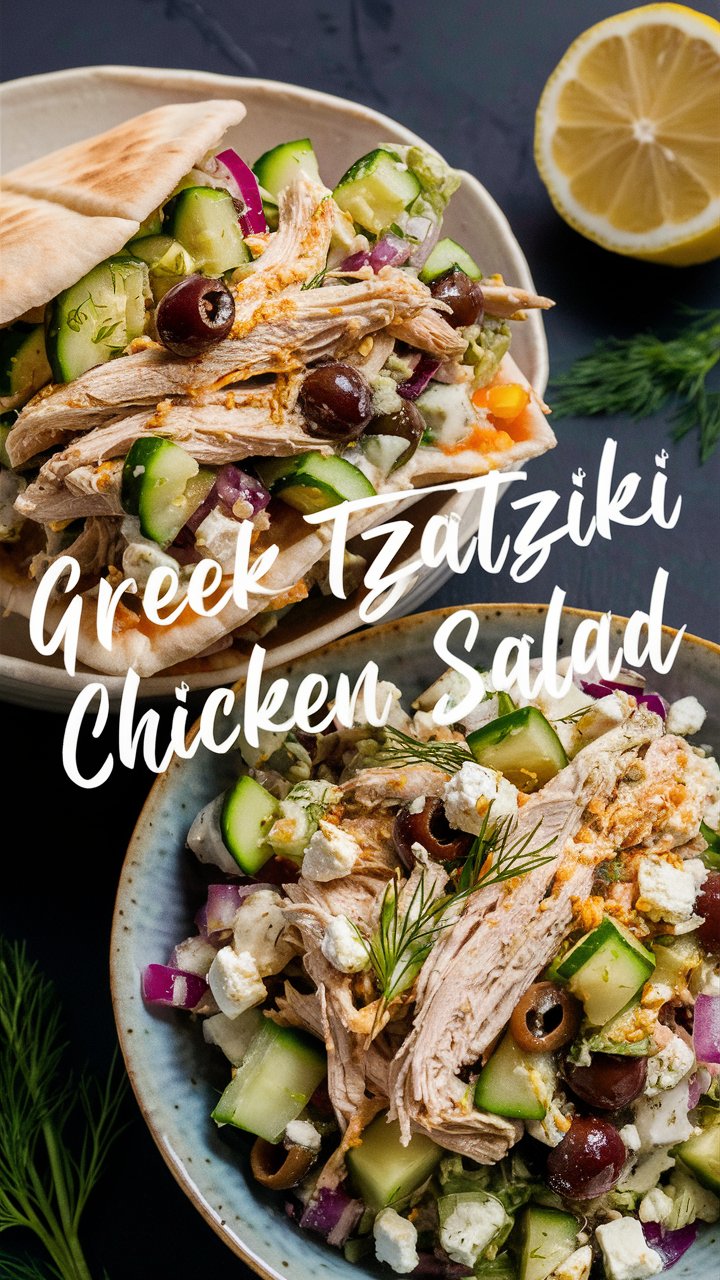
Greek Chicken Salad with Lemon and Dill: A Refreshing Take on a Classic Dish 2025
If you love food that feels indulgent yet supports a balanced lifestyle, Greek chicken salad deserves a place at the top of your recipe list.
This single dish offers everything: lean protein, bright Mediterranean flavors, and a creamy, herb-infused yogurt dressing that rivals any mayonnaise-based salad—without the heaviness.
This comprehensive guide explores every aspect of Greek chicken salad, from its cultural roots to step-by-step preparation, smart ingredient swaps, storage strategies, and even ideas for turning leftovers into exciting new meals. Whether you’re a seasoned home cook or just beginning your culinary journey, you’ll find practical tips and creative inspiration here.
1. Why Greek Chicken Salad Has Global Appeal
The Mediterranean diet has long been celebrated for promoting heart health, longevity, and vibrant flavor. Central to this cuisine are fresh vegetables, lean proteins, herbs, olive oil, and fermented dairy—all starring players in Greek chicken salad.
Unlike heavy mayonnaise-based salads, this version highlights the bright acidity of lemon, the cool freshness of cucumber, and the herbaceous kick of dill, all bound together by Greek yogurt, which adds creaminess without excess fat.
This balance of taste and nutrition explains the dish’s worldwide popularity. From New York cafés to beachside tavernas in Santorini, Greek chicken salad appears in countless forms, each one adaptable to local tastes while retaining its Mediterranean soul.
2. Core Ingredients and Their Nutritional Benefits
Understanding the health profile of each component not only improves flavor but also helps you tailor the salad to personal dietary needs.
Greek Yogurt
Rich in protein and probiotics, Greek yogurt provides a creamy texture with less saturated fat than mayonnaise. It supports gut health and keeps you feeling full longer.
Chicken
Lean, high-quality protein is key to muscle repair and sustained energy. Rotisserie chicken is convenient, but you can also use poached or roasted breasts or thighs.
Cucumber
Low in calories yet high in water content, cucumber lends crunch and hydration. Removing excess liquid prevents the dressing from becoming watery.
Fresh Dill
Dill adds a distinct anise-like note and is packed with antioxidants, vitamins A and C, and trace minerals.
Garlic and Lemon Juice
Both ingredients brighten flavor and provide immune-supportive nutrients. Lemon’s acidity naturally tenderizes meat and balances the creaminess of yogurt.
Red Onion
Red onion offers a mild bite and vibrant color, plus beneficial plant compounds like quercetin.
Optional Add-Ins
Tomatoes, bell peppers, olives, or even a sprinkle of feta cheese can introduce additional fiber, healthy fats, and savory depth.
3. Step-by-Step Recipe: Classic Greek Chicken Salad with Yogurt Dill Dressing
This master recipe serves 4 generous portions.
Ingredients
- 1 medium cucumber (about 1 cup when grated)
- ¾ cup full-fat Greek yogurt
- 2 tablespoons fresh dill, finely chopped
- 1 tablespoon freshly squeezed lemon juice
- 1 clove garlic, minced
- ½ teaspoon sea salt
- ¼ teaspoon black pepper
- 3 cups cooked chicken, shredded (from about 1 ½ pounds rotisserie chicken)
- ½ cup finely diced red onion
Method
- Prepare the Cucumber
Grate the cucumber, then wrap it in a clean kitchen towel or paper towels. Squeeze firmly to remove as much water as possible. This prevents the salad from becoming thin. - Make the Yogurt Dill Dressing
In a medium bowl, combine the yogurt, dill, lemon juice, garlic, salt, and pepper. Stir until smooth and creamy. - Combine
Add the shredded chicken and diced onion to the dressing. Fold gently until every piece of chicken is coated. - Chill and Serve
Cover and refrigerate for at least 30 minutes to allow flavors to meld. Serve chilled on warm pita, in lettuce wraps, or over a bed of mixed greens.
4. Pro Techniques for a Restaurant-Quality Result
- Use Full-Fat Yogurt
Low-fat versions can separate or taste chalky. Full-fat Greek yogurt yields a luxurious texture while still being nutritious. - Balance Acidity and Salt
Taste and adjust lemon juice or salt after chilling, since cold foods can seem less seasoned. - Fine Shredding
Chop chicken into small, even pieces so every bite carries dressing and herbs. - Make Ahead
Prepare the dressing a day early. Flavors deepen overnight, creating a richer final dish.
5. Variations: From Low-Carb to High-Fiber
One reason Greek chicken salad remains a perennial favorite is its adaptability.
- Low-Carb/Keto: Serve in lettuce cups or over spiralized zucchini instead of bread or crackers.
- High-Fiber: Add cooked quinoa, farro, or chickpeas to boost fiber and create a heartier entrée.
- Herb Switch: Replace dill with fresh mint or parsley for a new aromatic profile.
- Spicy Mediterranean: Add a pinch of cayenne or drizzle with harissa for subtle heat.
- Vegetable Boost: Dice bell peppers, cherry tomatoes, or artichoke hearts for extra color and nutrients.
6. Serving Suggestions for Every Occasion
Greek chicken salad transitions seamlessly from weekday lunches to dinner-party appetizers.
- Casual Lunch: Spoon onto whole-grain pita with sliced tomatoes and baby spinach.
- Elegant Appetizer: Serve in endive leaves or cucumber cups for a light starter.
- Picnic-Friendly: Pack in mason jars with a base of greens and a layer of salad on top.
- Family Dinner: Pair with roasted potatoes, grilled vegetables, or a simple Greek lentil soup.
For a refreshing beverage, consider sparkling water with lemon or a chilled glass of dry white wine like Assyrtiko.
7. Meal-Prep and Storage Strategies
- Refrigeration: Store in an airtight container for up to three days. Stir before serving if any natural separation occurs.
- Not Freezer-Friendly: Yogurt-based sauces can separate when thawed. If you must freeze, store only the shredded chicken and add dressing later.
- Portion Control: Divide into single-serve containers for quick lunches or snack plates.
8. Pairing Ideas: Drinks, Sides, and Garnishes
Elevate your meal with complementary flavors:
- Sides: Roasted lemon potatoes, tabbouleh, or a simple cucumber-tomato salad.
- Breads: Warm naan, pita chips, or seed crackers.
- Extras: Kalamata olives, marinated artichokes, or a sprinkle of crumbled feta.
- Drinks: Herbal iced tea, chilled rosé, or sparkling citrus water.
9. Frequently Asked Questions
Can I make it dairy-free?
Yes. Substitute coconut yogurt or a thick almond-based yogurt for Greek yogurt.
Can I use regular yogurt instead of Greek?
You can, but strain it through cheesecloth to remove excess liquid for a thicker dressing.
How do I keep the salad from becoming watery?
Always squeeze the cucumber and use full-fat yogurt to reduce separation.
Is it gluten-free?
The salad itself is naturally gluten-free. Just choose gluten-free bread or crackers if desired.
How far in advance can I make it?
It tastes best within three days, but you can prepare the dressing 24 hours ahead to save time.
10. Final Thoughts and Next Steps
Greek chicken salad with yogurt dill dressing is more than a recipe—it’s a gateway to Mediterranean cooking.
It embodies balance: creamy yet light, refreshing yet satisfying, and endlessly customizable. With its rich protein content, vibrant vegetables, and probiotic-rich dressing, it fits seamlessly into a health-conscious lifestyle without sacrificing flavor.
Whether you’re preparing weekday lunches, hosting a summer brunch, or simply craving a nourishing meal after a busy day, this dish offers everything you need in a single bowl.
Experiment with seasonal herbs, vary your vegetables, or fold leftovers into wraps for a quick lunch.
Take the time to grate that cucumber, chop the dill, and taste as you go. The reward is a salad that’s as beautiful on the plate as it is beneficial to your body—one you’ll return to again and again.

